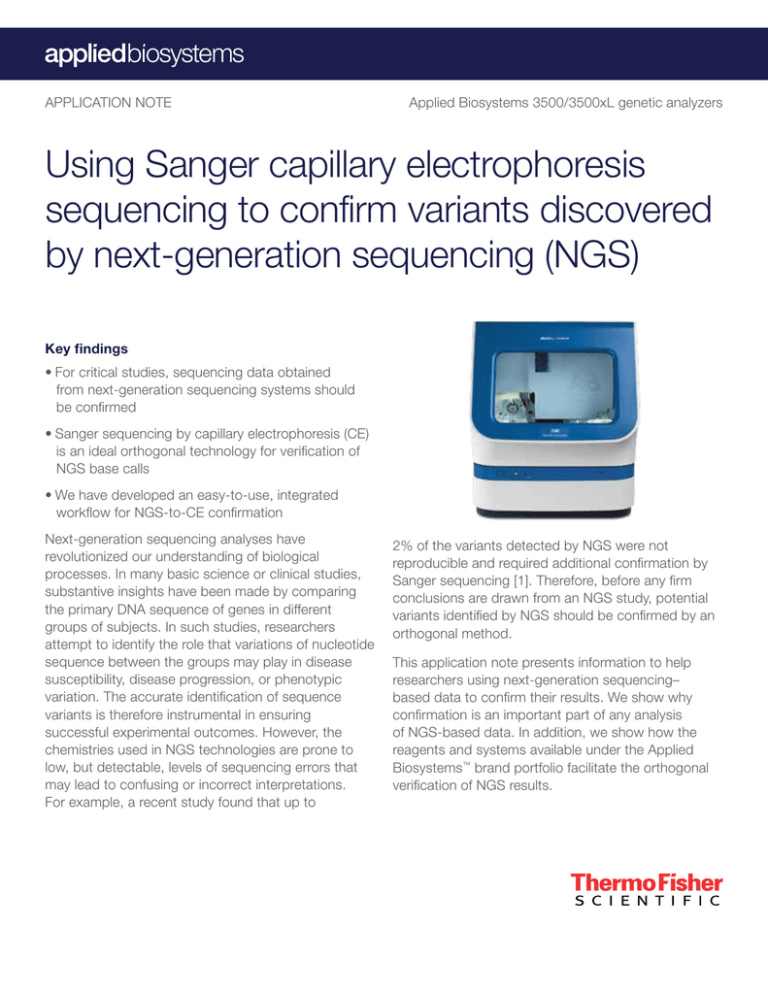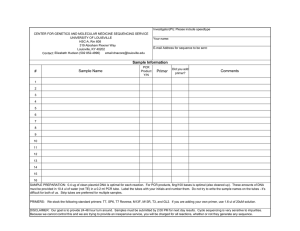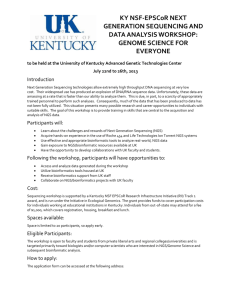
APPLICATION NOTE
Applied Biosystems 3500/3500xL genetic analyzers
Using Sanger capillary electrophoresis
sequencing to confirm variants discovered
by next-generation sequencing (NGS)
Key findings
•For critical studies, sequencing data obtained
from next-generation sequencing systems should
be confirmed
•Sanger sequencing by capillary electrophoresis (CE)
is an ideal orthogonal technology for verification of
NGS base calls
•We have developed an easy-to-use, integrated
workflow for NGS-to-CE confirmation
Next-generation sequencing analyses have
revolutionized our understanding of biological
processes. In many basic science or clinical studies,
substantive insights have been made by comparing
the primary DNA sequence of genes in different
groups of subjects. In such studies, researchers
attempt to identify the role that variations of nucleotide
sequence between the groups may play in disease
susceptibility, disease progression, or phenotypic
variation. The accurate identification of sequence
variants is therefore instrumental in ensuring
successful experimental outcomes. However, the
chemistries used in NGS technologies are prone to
low, but detectable, levels of sequencing errors that
may lead to confusing or incorrect interpretations.
For example, a recent study found that up to
2% of the variants detected by NGS were not
reproducible and required additional confirmation by
Sanger sequencing [1]. Therefore, before any firm
conclusions are drawn from an NGS study, potential
variants identified by NGS should be confirmed by an
orthogonal method.
This application note presents information to help
researchers using next-generation sequencing–
based data to confirm their results. We show why
confirmation is an important part of any analysis
of NGS-based data. In addition, we show how the
reagents and systems available under the Applied
Biosystems™ brand portfolio facilitate the orthogonal
verification of NGS results.
Why is orthogonal verification of NGS-based
data important?
Sanger-based capillary electrophoresis
sequencing solutions
System-dependent sequencing biases
One of the workhorses of the genomic community
for the last quarter century has been Sangerbased sequencing: polymerase termination with
fluorescent dideoxynucleotides followed by sequence
collection on automated capillary electrophoresis
(CE) instruments. This is a robust and inexpensive
method with chemistries and analysis tools that are
easy to use and well understood—and because of
its high accuracy and ease of data interpretation, it
is considered to be the gold standard technology
for DNA sequence analysis. It is therefore an ideal
system for confirming variant calls made on NGS
platforms. We have been at the forefront of improving
CE sequencing technologies, and offer a complete
solution for CE sequencing needs. From finding and
resourcing predesigned amplification primers and
PCR reagents, through BigDye™ chain-termination
sequencing reagent mixes, capillary electrophoresis,
and finally, data analysis software, Applied
Biosystems™ products cover the entire CE workflow
(Figure 1). In the sections below, we provide detailed
information on the reagent choices, CE systems, and
workflows that have been optimized for confirming
NGS data by Sanger CE sequencing.
Confirming NGS results requires more than just
repeating the sequencing on the same platform.
Repeat sequencing will not eliminate all errors,
because there could be sequencing biases that are
specific to the platform being used. For example, GCrich regions can be particularly hard to read through.
They therefore can introduce misincorporation errors,
the specific type of which can be influenced by the
sequencing system used [2]. Similarly, errors can be
introduced when sequencing through homopolymeric
sequences [2]. Further, the library preparation method
used can also potentially introduce systematic
biases (e.g., strand bias) [3]. Lastly, different .bam file
alignment and variant caller software can yield different
(erroneous) results even for “relatively simple” single
nucleotide variants (SNVs) [4,5]. These different types
of errors have different frequencies and modalities that
vary from system to system. Thus, they are unlikely
to be resolved by simply resequencing on the same
platform. Verification of any sequence variant therefore
depends on reanalysis using a different platform that
does not have the same systemic biases.
Uneven coverage may produce uneven accuracy
Another source of uncertainty can arise from uneven
coverage of NGS sequencing reads. Uneven
coverage issues arise in NGS analyses because
not all sequences can be sequenced with the same
efficiency. Sequences that are more difficult for
the polymerase to read through due to secondary
structure, highly repetitive sequences, or other factors,
will be underrepresented in the subsequent data
files. In addition, some NGS targeted sequencing
approaches depend on capture by hybridization
before library preparation [6]. This hybridization, too,
can be highly sequence-dependent and can affect the
representation of some sequences in the final libraries.
And because confidence in the results is highly
dependent on the number of instances of sequences
detected, any regions that are underrepresented in
the final data output could be more suspect, reducing
confidence that variants detected are real.
Tool
Variants
identified
by NGS
Choose
primers in
the Primer
Designer
Tool
Direct
sequencing
Prep with
Big Dye
Direct
Sequence
on a 3500
Genetic
Analyzer
Variants
determined
in NGC
Figure 1. NGS-to-CE workflow. A complete workflow for verifying
variants discovered by NGS systems is shown. Applied Biosystems
products have been designed to be optimized to work together. NGS
variants that are marked for verification can be directly imported into the
Primer Designer Tool for picking and ordering appropriate PCR primer
pairs that can be directly sequenced with the BigDye™ Direct sequencing
kit and the 3500 Genetic Analyzer. The resulting data (.vcf file from NGS
and .ab1 trace files from CE) are then aligned and compared in the NextGeneration Confirmation (NGC) tool in Thermo Fisher Cloud.
The Primer Designer Tool: the right source for
predesigned PCR primer pairs for CE sequencing
The Primer Designer™ Tool is a web-based
application (thermofisher.com/primerdesigner)
that greatly facilitates the search and selection of
optimal PCR primer pairs that help meet your needs
for resequencing any exon of the human exome or
sections of the mitochondrial genome (Figure 2).
amplicons with amplicon lengths shorter than 200
bp). The use of these Ion AmpliSeq™ primer pairs for
resequencing individual targets by Sanger sequencing
is described in detail in a different application note [7].
The Primer Designer Tool offers the choice of
designing primers with or without M13 universal
sequencing primers. However, having M13-tailed
primers facilitates the sequencing workflow and we
Figure 2. The Primer Designer Tool simplifies choosing sequences for CE sequencing. The user interface clearly indicates where sequence
information is to be entered (left). The software will then present primers optimal for PCR amplification followed by cycle sequencing. Details about primer
position on a locus map, amplicon length, and transcripts recognized can be visualized once the locus is chosen (right)
The Primer Designer Tool comprises a virtual design
collection of over 650,000 primer pairs yielding
amplicons ranging from 125 to 600 bp that cover
95.9% of human coding exons and 74.9% of human
noncoding exons, as well as the human mitochondrial
genome. Complete sequence coverage is achieved
for 94% of coding exons. Sophisticated bioinformatics
rules and filters were applied to help ensure high
target specificity, and minimize the formation of primer
dimers. The tool also contains the primer pairs used
in the Ion AmpliSeq™ exome panel (n = 283,961
amplicons ranging from 200 to 400 bp) and the
Ion AmpliSeq™ Cancer Hotspot Panel v2 (n = 207
therefore recommend incorporating them into the
primer designs.
To make it easier to validate Ion Torrent™ NGS data
with CE, we provide direct links from the Torrent
Suite™ Variant Caller software into the Primer
Designer Tool (Figure 3). This feature allows users to
enter sequences from the Torrent Suite Variant Caller
data page directly into the Primer Designer Tool,
where they can be used to design and order primers.
Alternatively, the Primer Designer Tool accepts other
common sequence file formats, such as .vcf files
exported from NGS platforms, or direct entry of
genomic coordinates flanking the region of interest.
Figure 3. Output from Torrent Suite Variant Caller software can be entered into the Primer Designer Tool. Variants of interest detected by
semiconductor sequencing can be selected by check mark and exported directly into the Primer Designer Tool. This facilitates the ordering of primers
needed to confirm the Ion Torrent sequencing results by CE sequencing.
BigDye Direct Cycle Sequencing Kit simplifies
workflow
The primers designed using the Primer Designer Tool
can be used to generate amplicons for sequencing
by ordinary PCR from the starting template. However,
to facilitate generating and sequencing these
amplicons, we developed the Applied Biosystems™
BigDye™ Direct Cycle Sequencing Kit (Cat. No.
4458688), a single-tube solution that is easy to use
and significantly reduces hands-on time (up to 40%)
at the bench. This kit provides the PCR reagent to
amplify the target of interest, the sequencing reagent,
and special M13-sequencing forward and reverse
primers to sequence both strands. The only reagents
that need to be supplied by the user are the DNA
template (typically 5–10 ng) and the PCR primer pair
for the amplicon to be sequenced. Note that the PCR
forward and reverse target-specific primers need to
be tagged with respective M13 sequences to allow
the sequencing primers to anneal in the sequencing
reaction. A significant advantage of the BigDye Direct
workflow is that the whole workflow can be completed
in a single tube (per sample)—that is, there is no need
for a sample transfer into a different tube or plate. A
single-tube solution that eliminates reagent transfers
therefore eliminates a critical source of error. This also
minimizes experimental variability caused by multiple
handling steps, and in the end helps save researchers
up to 3 hours of processing time (Figure 4). To use the
kit, template is mixed with the amplification primers
and reagents, and amplified by PCR. Next, the
sequencing primers and reagents are added to the
same tube and PCR cycled for sequencing. Finally,
unincorporated dyes from the sequencing reaction are
removed using the Applied Biosystems™ BigDye™
XTerminator™ Purification Kit (Cat. No. 4376484)
without the need to transfer the sequencing products
to a new tube. Alternatively, the reaction is passed
through a spin column. The cleaned-up, purified
sequencing fragments are now ready to be applied to
the analyzer.
BigDye Direct Cycle Sequencing Kit workflow, run with POP-7™ Polymer
Four steps in approximately five process hours
PCR Amplification
PCR Clean-Up
and Cycle Sequencing
84 min
90 min
Sample
Purification
Capillary
Electrophoresis
50 min
75 min
A traditional cycle sequencing workflow, run with POP-6™ Polymer
Five steps in approximately eight process hours
PCR Amplification
140 min
PCR Clean-Up
60 min
Cycle Sequencing
90 min
Sample
Purification
50 min
Capillary Electrophoresis
145 min
Figure 4. BigDye Direct Cycle Sequencing Kit increases speed and
accuracy of cycle sequencing. Combining PCR clean-up and cycle
sequencing into a single step reduces the traditional CE sequencing
workflow by 40% and reduces the potential for errors.
The 3500/3500xL family of genetic analyzers
For reading the sequence information, we
developed the easy-to-use 3500 family of capillary
electrophoresis genetic analyzers. Depending on
throughput needed, the analyzers are available in
8-capillary (3500) and 24-capillary (3500xL) formats.
The system features an advanced long-life solidstate laser, operates using standard power outlets,
and has a small footprint, facilitating easy setup and
operation. Hands-on time is reduced by the availability
of ready-to-use, load-and-run consumables. The
consumables are preformulated and packaged for
single use, so the possibility of mixing and handling
errors is minimized. The consumables also include
integrated radio frequency identification (RFID) tags
on the product labels. These enable viewing, tracking,
and reporting of critical information about reagents
and consumables, including usage, lot number, part
number, expiry date, and on-instrument lifetime within
the 3500 Series Data Collection Software. These
features help streamline critical daily administrative
tasks, to help save time and effort when tracking
system performance.
The 3500 genetic analyzer family was primarily
developed for ease of use. Sample and consumable
loading are intuitive and, once loaded, operation of
the instrument is fully automated. Because the data
is obtained by progressive electrophoretic reading
of single nucleotide–length differences of fragments,
sequence data can be obtained in as little as 1 hour.
Analysis of CE data and confirmation of
NGS variants
The data analysis software on the 3500 genetic
analyzer family provides user-friendly navigation
with its intuitive dashboard design. It also offers
preconfigured plate templates to further support rapid
and efficient sequence analysis. Thermo Fisher Cloud
(http://www.lifetechnologies.com/us/en/home/
cloud.html) contains a convenient and free-to-use
tool: the QC module in the Sanger section allows
scientists to view, quality check, manage, and share
sequencing data. To conduct variant analysis of CE
data and directly compare variants from the relevant
NGS .vcf file with the sequence output from the 3500
Genetic Analyzer, a subscription to use the Variant
Analysis (VA) and Next Generation Conformation
Figure 5. Alignment of Sanger CE trace files with NGS .vcf file data. The alleles identified and imported in the NGS .vcf file are shown with a blue bar.
Alleles identified by CE sequencing are shown with a red bar. Note the G→A allele identified by NGS was confirmed by CE. Several alleles were identified
by CE only; these were not present in the NGS .vcf file due to shorter read length.
(NGC) module can be purchased (Figure 5). The NGC
module is a powerful tool that can bring NGS and
Sanger data together to generate a comprehensive
side-by-side comparative report. To that end a .vcf file
from an NGS run is uploaded together with Sanger
sequencing files (.ab1) generated using the Primer
Designer Tool assays described above. The software
displays a visual alignment of both file types and
the user can examine the trace profiles to verify the
accuracy of the base call (Figure 6). Together, these
features make the 3500 Genetic Analyzer one of the
easiest capillary electrophoresis systems to use.
CE (Conformité Européenne) mark. This designation
is required for clinical research throughout the EU.
An RFID tagging technology has been incorporated
into all key consumables, allowing the laboratory to
track consumable usage for the administrative records
required in regulated environments.
Next-generation sequencing for discovery,
capillary electrophoresis for confirmation
NGS platforms offer unprecedented scales of
sequence determination, but also introduce the
need to make sure the information obtained in
Figure 6. Review of variants detected by Sanger sequencing traces in the NGC module of Thermo Fisher Cloud. The NGC module generates a
combined NGS and Sanger .vcf file and an annotated variant report.
Solutions for clinical science researchers
The promise of personalized medicine means that
more sequencing solutions are required in clinical
research laboratories. These laboratories need
extra layers of controls and safeguards to ensure
that precious samples are properly utilized and not
wasted. In addition, the instrumentation and reagents
must be robust so that the correct answer is returned
to the clinical science researchers and subjects. The
3500 Genetic Analyzer systems have received the
these discovery-based experiments is correct. CE
sequencing offers an ideal mechanism to confirm the
presence of variants uncovered by NGS systems. First,
the CE sequencing workflow is less labor intensive
than NGS, minimizing time to results, minimizing
costs, and minimizing the possibilities of user errors.
Second, because CE sequencing focuses on longer
reads of a single-target region, analysis of the data is
more straightforward than NGS data analysis. Finally,
because NGS and CE sequencing use different
chemistries for sequence determination, systemic
errors are less likely to occur in both systems. Any
variants that are detected by both NGS and CE
sequencing are therefore likely to be genuine.
Summary
In this application note, we described a complete
workflow for confirming next-generation sequencing
data by capillary electrophoresis. We showed how the
Primer Designer Tool facilitates selection and ordering
of primers needed for CE sequencing. We showed
the simplicity of ordering CE primers directly from Ion
Torrent Variant Caller software. We described how
the BigDye Direct kit provides a one-tube solution
for up-front PCR and sequencing work, and how the
3500 family of CE sequencers offer ease of use and
control necessary for confirmation of variant calls.
Finally, we described how the CE software makes
the results easily interpretable. Together, these tools
allow scientists performing basic or clinical research to
easily and quickly generate high-quality confirmation
data of sequences that are critical to make their
studies successful.
References
1. Gudbjartsson DF, Helgason H, Gudjonsson SA et al. (2015) Large-scale whole-genome
sequencing of the Icelandic population. Nat Genet 47(5):435–444.
2. Ross MG, Russ C, Costello M et al. (2013) Characterizing and measuring bias in
sequence data. Genome Biol 14(5):R51.
3. van Dijk EL, Jaszczyszyn Y, Thermes C (2014) Library preparation methods for nextgeneration sequencing: tone down the bias. Exp Cell Res 322(1):12–20.
4. Ding L, Wendl MC, McMichael JF, Raphael BJ (2014) Expanding the computational
toolbox for mining cancer genomes. Nat Rev Genet 15(8):556–570.
5. Kim SY, Speed TP (2013) Comparing somatic mutation-callers: beyond Venn diagrams.
BMC Bioinformatics 14:189.
6. Wall JD, Tang LF, Zerbe B et al. (2014) Estimating genotype error rates from highcoverage next-generation sequence data. Genome Res 24(11):1734–1739.
7. Sanger sequencing of FFPE genomic DNA and Ion Ampliseq library pools using the
enhanced Primer Designer Tool. Available at thermofisher.com/ceapplications
To learn more, go to
thermofisher.com/primerdesigner
For Research Use Only. Not for use in diagnostic procedures. © 2015 Thermo Fisher Scientific Inc. All rights reserved. All trademarks
are the property of Thermo Fisher Scientific and its subsidiaries unless otherwise specified. CO018905 1015





